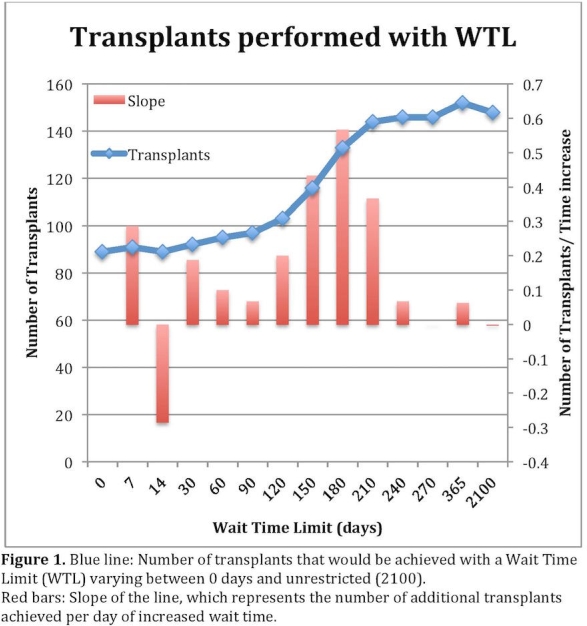How Long Is Too Long? The Impact of Bridge Donor Waiting Time on Paired Donation Transplants
D. Fumo,1,2 T. Suttle,1 R. Flynn,1 S. Stepkowski,1 L. Reece,2 J. Kopke,2 M. Rees.1,2
1University of Toledo Medical Center, Toledo, OH
2Alliance for Paired Donation, Maumee, OH.
Meeting: 2015 American Transplant Congress
Abstract number: B167
Keywords: Donors, Kidney transplantation, Methodology, unrelated
Session Information
Session Name: Poster Session B: Living Donor Issues 1
Session Type: Poster Session
Date: Sunday, May 3, 2015
Session Time: 5:30pm-6:30pm
 Presentation Time: 5:30pm-6:30pm
Presentation Time: 5:30pm-6:30pm
Location: Exhibit Hall E
Non-simultaneous Extended Altruistic Donor (NEAD) chains and bridge donors (BD) are increasingly utilized in the field of Kidney Paired Donation (KPD), but remain controversial due to the possibility that such donors could renege on their promise to donate a kidney. The donor at the end of a NEAD chain is referred to as a BD, who is re-entered into the pool and trusted to donate after their incompatible recipient has received a transplant. This study evaluates how long bridge donors should wait.
Data from a single United States KPD matching program was analyzed. To understand the impact of a BD failing to donate, a theoretical model was created in which a wait time limit (WTL) was placed on BDs. If the WTL was reached, the bridge donor was directed to the deceased donor waitlist and the chain was ended. If the WTL was not reached before a donor reneged, the chain ended with no additional transplant to the waitlist.
90 BDs were used in 26 NEAD chains to complete 151 transplants. 9 BDs (10%) are currently suspended or withdrawn from the KPD pool. Though some of these donors may eventually donate, they were assumed to have reneged. Of the 9 BD who appear to have reneged, most were subsequently denied as donors for medical reasons; only 2 of 90 (2.2%) simply chose not to donate. No BD in a planned NEAD chain has failed to donate, so only BDs without initially identified recipients were included in the model (n=61). The maximum number of transplants was achieved with a WTL of 365 days (Figure 1), which would have resulted in 152 transplants/6 reneges. An unlimited WTL resulted in 148 transplants/9 reneges, while not allowing BDs to wait (WTL=0) would have achieved 89 transplants/0 reneges. The most significant gains were seen between 120 and 210 days (97 to 144 transplants). 4 BDs reneged at 210 days, with an additional 2 between 210 and 365 days.

This data suggests that a reasonable BD WTL should be at least 7 months, but not more than 1 year. To date, most BD reneging is actually medical disqualification, rather than a choice by the donor not to donate.
To cite this abstract in AMA style:
Fumo D, Suttle T, Flynn R, Stepkowski S, Reece L, Kopke J, Rees M. How Long Is Too Long? The Impact of Bridge Donor Waiting Time on Paired Donation Transplants [abstract]. Am J Transplant. 2015; 15 (suppl 3). https://atcmeetingabstracts.com/abstract/how-long-is-too-long-the-impact-of-bridge-donor-waiting-time-on-paired-donation-transplants/. Accessed July 1, 2025.« Back to 2015 American Transplant Congress
